A Paipo Interview with Dennis Markson
January 25-26, 2011- Auckland, New Zealand
E-Mail interview by Bob Green
Photos courtesy of Dennis Markson
Dennis and friends body-surfed, dived and
rode what they called skimmers - small ply paipo. Living overseas
Dennis made and rode boards when he got the opportunity in locations
from Gibraltar to the U.S.
|
1. How did you first get involved in
riding skimmers. Was this a name that was around at the time or did one
of your friends come up with it?
The goup of diver/surfers that I was a part
of started making them and I followed. The name I think just came from
its action in the water. There was of course another skimmer that
people jumped on when the waves receded off the sand, but this was a
different shape and not used by surfers.
2. When and where did you start riding these boards?
Around the latter part of 1963. We surfed the Sydney beaches and up and down the coast. But Maroubra was our home territory.
3. At that time were there others besides your friends riding bellyboards?
No one that we saw or heard of.
|
|
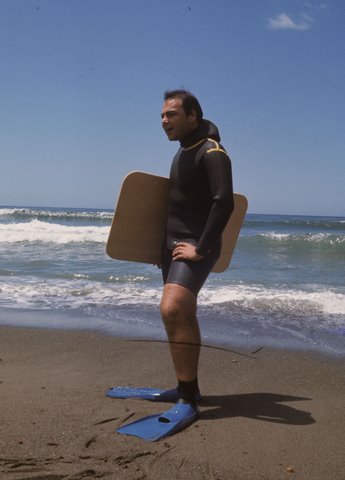
Dennis Markson with a 'skimmer' ca.
1968/1969.
|
John Dunn. Lurline, June 1964.
|
|
Unidenitifed bodysurfer - Little Avalon, May 1964.
|
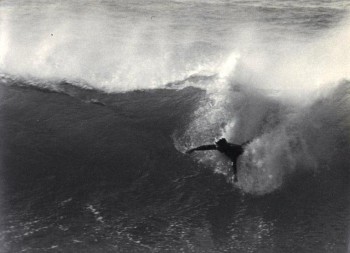
|
|
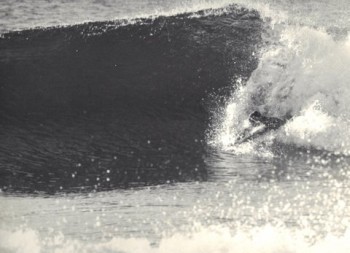
|
Photos by John Pennings.
|
Lurline Bay and Little Avalon were favourite spots. That is Aden Parsons bodysurfing.
|
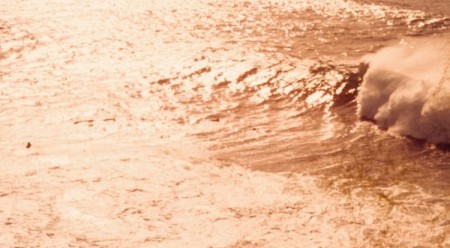
|
|
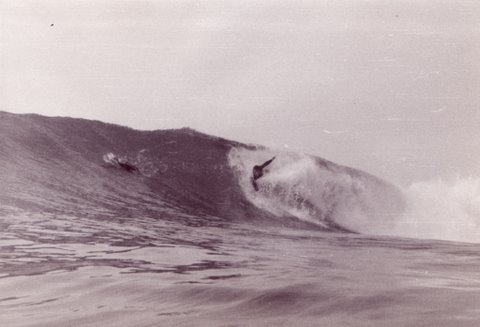
|
Photos courtesy Dennis Markson.
4. Who made the boards and did the design evolve much over time?
We made them ourselves, I think they were all
a little different although about the same size. They were very simple,
just 5-ply and varnished, no wax.
What were the dimensions of these boards?
Now the size changed a little with your height. I think my size for the
skimmer was about 20 inches x 36 inches. And for the foam and glassed paipo
board that I had made for me by Limey at Huntington Beach, I think I
went to 42 inches. I think this board should have been wider and dished a
little bit for the body to fit in, although it was flat bottomed. I found it
unstable because of its pin tail and I sold it. It is only my thought
but it would not be easy to do knees on.
They must have had limited buoyancy?
Yes, the boards had limited buoyancy, but they did float. They were easy
to take deep under a wave (not like a boogie board) and with forward
water pressure angled upwards this helped you to the surface. More
importantly, when you wiped out the board just popped up next to you (remember this is pre leg- or hand-rope times).
Did you ever try a fin on your board?
Yes we did and John Dunn (JD) had fins on his board. What we found was
when requiring a fin (steep sections) you just held the opposite nose
up slightly and the rear edge went into the wave like a hydrofoil, so
you dug the rear edge in. That plus your shoulder made you a board/body
surfer. This helped to counter any side
slip, although there was always a tendency to slip down the face of the steeper waves, but as I
remember it didn't worry us, and for slight waves like the 45th Street groin
(see photo) the
board just slipped along.
5. Who else rode skimmers and where did you mostly surf? Did you travel much or just surf around Maroubra?
All the group used them at some time or
another (Peden, Koller, Dunn, Holden, Harold, Boomer, Parsons). We
travelled up and down the coast, but mostly southern Sydney
beaches (see Note 1).
Left
to right: John Holden, Aden Parsons, Dennis Markson, John Dunn and Paul
Koller (missing Ian Peden, Lindsay Harold and Colin Boomer). Photo
taken at Little Avalon on May 9, 1964.
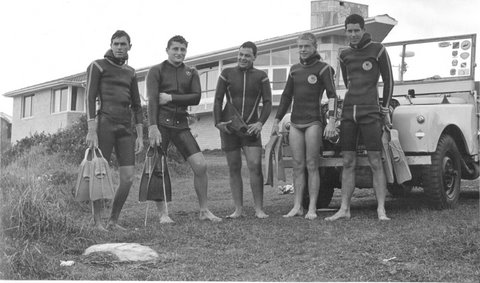
Photo by John Pennings.
Do you catch up with your surfing mates from the 1960s often?
Yes, we have continual contact through a very good web site, with
photos, videos, music of our day and discussions. And we have reunions
most times when I get to Sydney.
6. Why was Little Avalon called the Bin?
I remember the name being thought of by John
Dunn and Paul Koller, and it was named because just left of the takeoff
point over a rocky bottom the water swirled around into a bin shape and
the wave broke away from that.
Hand plane and a bellyboard at the Bin. "Hand planes were
around in the 1950s, and they are still used. I used a web glove that was
just as good, it allowed you to get a lot of weight out front, and by
pushing down you can lift the body partly out of the water and have
less drag." ca. 1964.
|
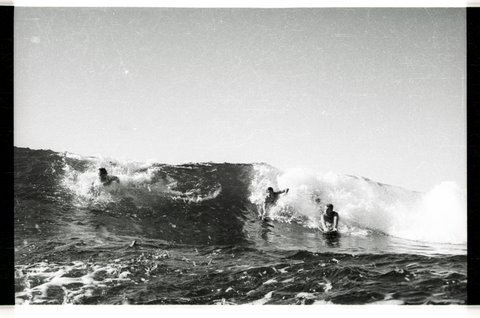
|
|
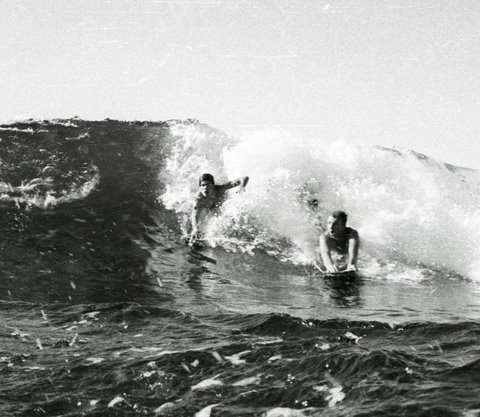
|
Photo courtesy Dennis Markson.
7. Did you see other bellyboards in your travels?
Not until I got to California in 1968, and they
were made like small surfboards. I had one in California made by Limey,
but I found it hard to ride because of its pintail. This is just prior
to the foam boogie boards. Some people were doing knees on glassed
paipo boards. I think the idea came from Hawaii.
Unknown surfers knee-riding paipo in Newport, August 1968 and October 1969.
|
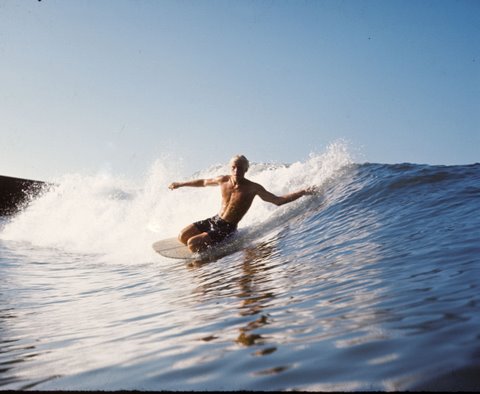
|
|

|
Photos courtesy Dennis Markson.
8. You were also into bodysurfing? Do you see much connection between bodysurfing and paipo riding?
Very much so, because of the prone position,
one was very close or partly in the water, you felt part of the wave.
There is something about being lifted by a wall of water as you are
propelled through it.
Dennis bodysurfing - May 6, 1964, at The Bin.
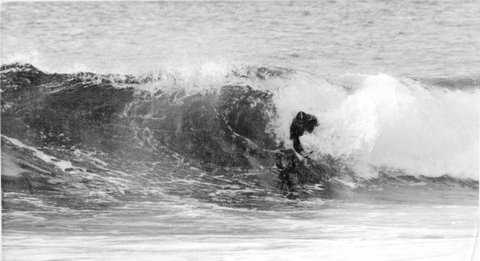
Photo by John Pennings.
Dennis at Newport ca. 1968.
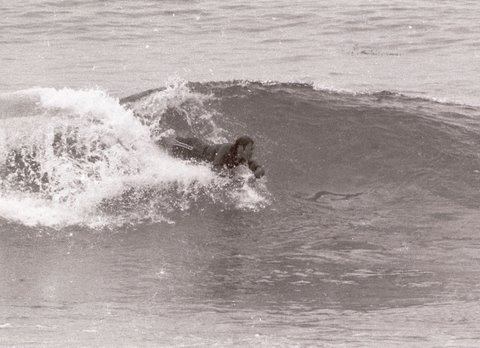
Photo courtesy Dennis Markson.
9. I've read that you and your friends
were experienced free-divers. This must have come in handy when
surfing. What technique was involved in holding your breath for an
extended period underwater?
Hyperventilation.
Did you ever experience problems using hyper-ventilation?
No, but we were fit.
Did your free-diving experience ever come in handy in the surf?
All the time -- especially in big surf.
Dennis with camera at Lurline, ca. 1963.
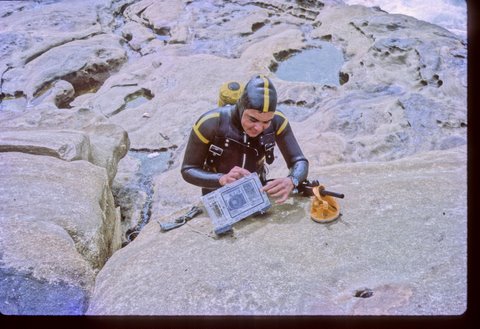
Photo courtesy Dennis Markson.
10. When did you begin your overseas travels? Where have you surfed a skimmer?
I left Sydney in 1964. In New Zealand, Great Barrier Island, Gibraltar, and California.
How long were you away for?
6 years.
Gibraltar isn't a well-known wave destination - what were the waves
like on your trip? Where did you get your best waves while away?
Gibralter had a small wave when the Atlantic swells came around
the corner, short and then shore break. Best waves when I was away were
California and Big Sur.
Newport 1969 and surfing 45th Street groin, August 1968.
|
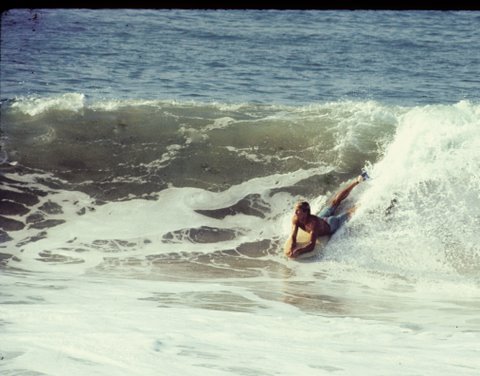
|
|
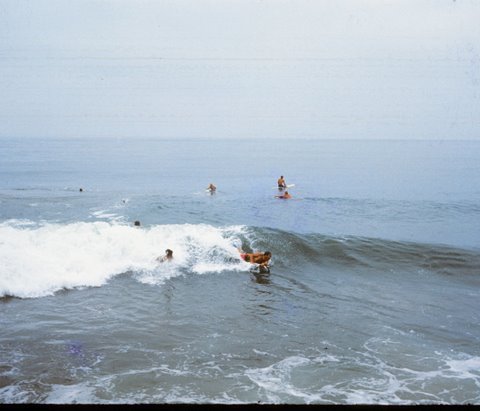
|
Photo courtesy Dennis Markson.
11. Would you carry a board with you or make one locally? Any experiences or surfs stand out from these travels?
Mostly they were made locally as was needed.
Was it difficult finding the materials to get a board made?
No, any hardware shop ask for off cuts.
But the speed of change and the advent of
the short surfboard forced me to adopt the boogie board. Now I could
surf where boards were not allowed. It became too dangerous fighting
for waves with the short boarders. And the "one wave, one person" policy
meant you never got a ride. You must remember that in California at the good
spots there could be thirty people or more in the water before the sun
came up. And eighty after that. I remember going to County Line and not
being welcome. The attitude in the water became unbearable. So I bought
a boogie.
Is riding a skimmer very different to riding a boogie board?
I think it is. A boogie board can be difficult at times because of
buoyancy, but at least you can put it under you to have a seat in the
water.
12. When did you move to New Zealand? Have you surfed a skimmer around New Zealand much?
I came back in 1970, and I only used a boogie.
13. In your travels have you seen many other paipo riders on either fibreglass or wood boards?
Only in California. I looked for spoons but only saw them in the movies.
Dennis at Balboa, CA, in 1969 and a paipo rider in Newport in 1968.
|
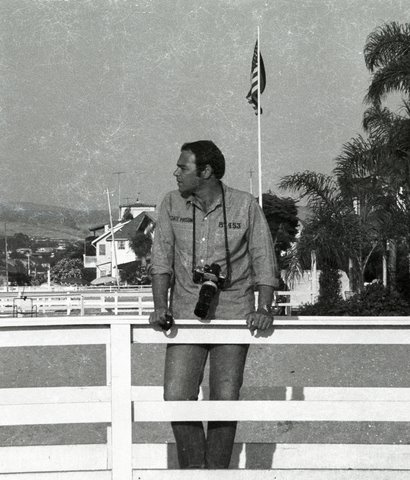
|
|
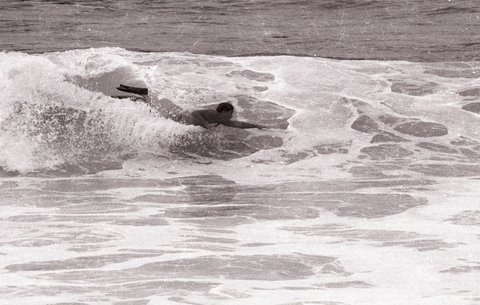
|
Photos courtesy Dennis Markson.
14. Do you still ride a skimmer?
No, only boogie. But since breaking an ankle
I find I can not use a fin so at age 69, I am out of the water. But it sure
is fun to watch those boogie riders at Bronte, they can do things I
could never do, and have taken the art to another level.
15. Any other comments?
No, I think I have said it all, except I sure had a lot of fun with the best Group of mates in the world.
|
Note 1. Photos of Dennis's friends can be found in the Paipo Interview with Ian Peden. |
|